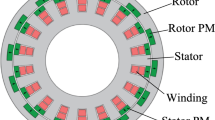Abstract
Permanent magnet vernier machine (PMVM) has low speed and high torque characteristics. However, conventional single-rotor single-stator PMVM cannot meet the requirements of a high power factor. In this paper, a dual stator permanent magnet vernier machine (DS-PMVM) with spoke array and high-temperature superconducting (HTS) bulks is proposed to improve the power factor of the PMVM. This model adds HTS bulks between the modulation teeth to effectively suppress the magnetic field penetration, thereby reducing the magnetic flux leakage. A parametric model of DS-PMVM with 16 pole pairs PM rotor and 2 pole pairs armature field is established., and some key parameters are optimized by the genetic algorithm. The electromagnetic performance of the proposed DS-PMVM is verified by comparing with the conventional machine through the finite element simulation, which shows that the torque density of the proposed machine can reach 47.4kN m/m3 and the power factor of 0.946 under the same conditions.














Similar content being viewed by others
References
Qu R, Liu Y, Wang J (2013) Review of superconducting generator topologies of direct-drive wind turbines. IEEE Trans Appl Supercond. https://doi.org/10.1109/TASC.2013.2241387
Wu F, EL-Refaie AM (2018) Permanent magnet vernier machines: a review. In: 2018 XIII international conference on electrical machines (ICEM), pp 372–378
Fang L, Li D, Qu R (2023) Torque improvement of vernier permanent magnet machine with larger rotor pole pairs than stator teeth number. IEEE Trans Ind Electron. https://doi.org/10.1109/TIE.2022.3232651
Li X, Chau KT, Cheng M, Kim B, Lorenz RD (2015) Performance analysis of a flux-concentrating field-modulated permanent-magnet machine for direct-drive applications. IEEE Trans Magn 51(5):1–11
Li D, Qu R, Lipo TA (2014) High-power-factor vernier permanent-magnet machines. IEEE Trans Ind Appl 50(6):3664–3674
**g L, Tang W, Liu W, Rao Y, Tan C, Qu R (2022) A double-stator single-rotor magnetic field modulated motor with HTS Bulks. IEEE Trans Appl Supercond 32(6):1–5
Arish N, Marignetti F, Yazdani Asrami M (2021) Comparative study of a new structure of HTS-bulk axial flux-switching machine. Phys C Supercond. https://doi.org/10.1016/j.physc.2021.1353854
Ardestani M, Arish N, Yaghobi H (2020) A new HTS dual stator linear permanent magnet Vernier machine with Halbach array for wave energy conversion. Phys C Supercond. https://doi.org/10.1016/j.physc.2019.1353593
Xu L, Zhao W, Liu G, Song C (2019) Design optimization of a spoke-type permanent-magnet vernier machine for torque density and power factor improvement. IEEE Trans Veh Technol 68(4):3446–3456
**g L, Tang W, Wang T, Ben T, Qu R (2022) performance analysis of magnetically geared permanent magnet brushless motor for hybrid electric vehicles. IEEE Trans Transp Electrif 8(2):2874–2883
Fan D, Quan L, Zhu X, **ang Z (2022) Design and optimization of double-stator vernier permanent magnet motor with improved torque characteristics based on flux modulation theory. IEEE Trans Magn 58(8):1–7
Cao X, Li G, Ye Q, Zhou R, Ma G, Zhou F (2017) Multi-objective optimization of permanent magnet synchronous motor based on elite retention hybrid simulated annealing algorithm. In: 2017 12th IEEE conference on industrial electronics and applications (ICIEA). Siem Reap, Cambodia, pp 535–540
Yildiz A, Polat M, Özdemir MT (2018) Design optimization of inverted switched reluctance motor using ant colony optimization algorithm. In: 2018 international conference on artificial intelligence and data processing (IDAP). Malatya, Turkey, pp 1–6
Liu X, Hu C, Li X, Gao J, Huang S (2021) An online data-driven multi-objective optimization of a permanent magnet linear synchronous motor. IEEE Trans Magn 57(7):1–4
Cunkas M, Akkaya R (2006) Design optimization of induction motor by genetic algorithm and comparison with existing motor. Math Comput Appl 11:193–203
Ainslie MD, Jiang Y, **an W, Hong Z, Yuan W, Pei R, Flack TJ, Coombs TA (2010) Numerical analysis and finite element modelling of an HTS synchronous motor. Phys C Supercond 470(20):1752–1755
Zou T, Li D, Qu R, Jiang D (2017) Performance comparison of surface and Spoke-type flux-modulation machines with different pole ratios. IEEE Trans Magn 53(6):1–5
**g L, Pan Y, Wang T, Qu R, Cheng P-T (2022) Transient analysis and verification of a magnetic gear integrated permanent magnet brushless machine with Halbach arrays. IEEE J Emerg Sel Top Power Electron 10(2):1881–1890
Hua Y, Zhu H, Gao M, Ji Z (2021) Multi-objective optimization design of permanent magnet assisted bearingless synchronous reluctance motor using NSGA-II. IEEE Trans Ind Electron 68(11):10477–10487
**g L, Liu W, Tang W, Qu R (2023) Design and optimization of coaxial magnetic gear with double-layer PMs and spoke structure for tidal power generation. IEEE/ASME Trans Mechatron. https://doi.org/10.1109/TMECH.2023.3261987
Xu L, Zhao W, Wu M, Ji J (2019) Investigation of Slot–pole combination of dual permanent magnet excited vernier machines by using air-gap field modulation theory. IEEE Trans Transp Electr 5(4):1360–1369
Acknowledgements
This work was supported by the National Engineering Laboratory of Energy-saving Motor & Control Technique (KFKT202213).
Author information
Authors and Affiliations
Corresponding author
Ethics declarations
Conflict of interest
The authors have no relevant financial or non-financial interests to disclose.
Additional information
Publisher's Note
Springer Nature remains neutral with regard to jurisdictional claims in published maps and institutional affiliations.
Rights and permissions
Springer Nature or its licensor (e.g. a society or other partner) holds exclusive rights to this article under a publishing agreement with the author(s) or other rightsholder(s); author self-archiving of the accepted manuscript version of this article is solely governed by the terms of such publishing agreement and applicable law.
About this article
Cite this article
**g, L., Kui, Z., Yang, K. et al. Genetic-Algorithm-Based Optimization of Dual Stator PM Vernier Machine with Spoke and HTS Bulks. J. Electr. Eng. Technol. 18, 3743–3750 (2023). https://doi.org/10.1007/s42835-023-01558-0
Received:
Revised:
Accepted:
Published:
Issue Date:
DOI: https://doi.org/10.1007/s42835-023-01558-0




